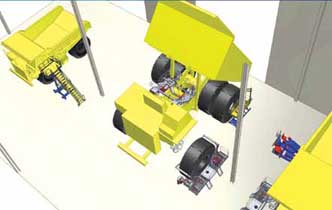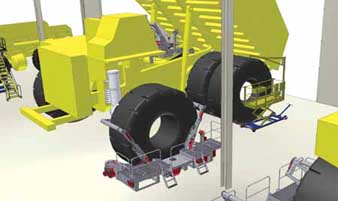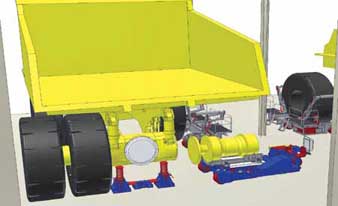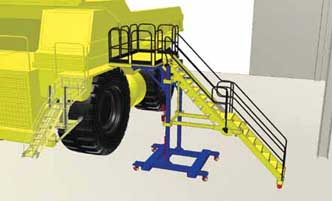The growth in the size of mining equip-ment places a priority on safety and
workshop efficiency. Advancements in
technology continue to offer opportuni-ties to dramatically improve safety per-formance and to achieve operational
excellence while maintaining mining
equipment. With the use of the latest
technologies, several new pieces of pur-pose-built equipment not only improve
methods for accessing and handling
heavy, hard-to-handle components, they
also allow the shop manager to use all of
the bays all of the time (See Figure 1).
As the size of mining equipment
grows, traditional methods for handling
components have become more haz-ardous. No one knows this more than the
technicians working on haul trucks at
large open-pit mines. The introduction of
ultra-class trucks in the mid-1990s
allowed the mines to move more ore or
coal. The components that maintenance
personnel must routinely handle, such
as tires, hubs and struts, drive lines,
wheel motors, suspensions, etc., all have
increased in size and weight. The prob-lem, however, is not just the size and
weight. The sheer size requires addition-al reach and height to access them.
Size and weight have increased pro-gressively with each new model. On a
Komatsu 730 haul truck for example, the
weight of the tire (a 37.00 R57) is a lit-tle more than 9,600 lb and has a diame-ter of 11.5-ft. For the Komatsu 830E,
the tire (a 40.00 R57) grew to more than
11,300 lb and 12.5 ft in diameter. The
Komatsu 930E has a tire (a 50.00 R57)
that weighs more than 15,700 lb and
measures 12.6 ft. On the Komatsu
960E, the tire (a 56.00 R63) weighs
16,500 lb and stands 12.7 ft in diame-ter. There are bigger tires and some tire
diameters exceed 13 ft.
Traditionally, these components are
moved by medium-sized pieces of equip-ment such as tire-handlers, mobile
cranes and forklifts. These items have
limitations due to their physical size,
maneuverability and safety. A number of
incidents occur every year involving the
machines used in this manner. A small
hub and strut weighs about 700 or 800
lb. One of the traditional methods used
to remove it is a forklift. As the compo-nents get larger, however, using the same
techniques just does not work. When
technicians use the same forklift to
remove a final drive on a Cat 793 haul
truck, the forks hit the ground and the
back wheels are in the air (See photo
below). Someone has miscalculated the
weight and center of gravity.
The 400-ton Cat 797 haul truck is
one of the largest pieces of mining equip-ment. A recent 797 repair job in
Indonesia required eight people or more
to pull the transmission. The photo
to the right shows six people on the truck.
There is another person operating the
mobile crane off to the side with another
person outside giving instructions to the
crane operator. They are using several
chain blocks to level the transmission,
while they try to manhandle it with their
feet. These guys are pretty far off the
ground without handrails and the tray is
on the truck. That is an accident waiting
to happen.
A lot of the issues that maintenance
technicians face involve not having the
right tools to do the job. In this case, the
right machines to remove the compo-nents and to handle them. Over the
years, mechanics have worked with slings
and chains wrapped around tires and
wheel motors. They have used cribbing
and assorted wood blocks to creatively
level hubs and struts. These techniques
place people in compromised positions.
These methods also have a negative
impact on the workshops as well. A series
of renderings shows an existing workshop
with a Cat 797 drawn to scale (See Figure
2). A mobile crane sits on one side and a
forklift with a tire handler sits on the other
side. Both of these pieces of equipment
have a 46-ft turning radius. If they are
going to perform any work, the bays on
both sides of the truck have to be empty.
When maintenance personnel remove
a transmission from a Cat 797 using tra-ditional methods, a mobile crane must
access the truck from the side. The mine
could remove the tray, which takes about eight hours, and use an overhead crane.
If the mine opts not to remove the tray
and it uses the crane, they will still
encounter the previously mentioned
manhandling issues.
The movement around a workshop is
constrained during big projects within a
limited workspace. A shop manager obvi-ously wants to use all of the bays and
they usually cannot afford to build a new,
bigger building. There are better, safer
ways to do this work.
New Technology Workshop
The design of future workshops needs to
focus on handling these large heavy
components safely and easily in restrict-ed spaces. Hedweld has designed
machines to do the tasks more safely
and efficiently. These renderings show
how a modern workshop should be
designed. All of the equipment is drawn
to scale and all of the machines are real
and they are either available now or they
will soon be available.
Figure 3 shows a transmission
removal device lifted into place with an
overhead crane. The unit can be seen sit-ting behind the cab. The tray is on the
truck. Both of the bays on either side are
being used. The unit has handrails and
has been specifically built for this type of
operation. A set of parallel arms moves a
winch forward into position to pick the
transmission up parallel based on its
center of gravity. A set of cylinders on the
sides of the winch allows the transmis-sion to be rotated to align the spline.
Figure 4 shows two machines, a tire
handler (left) and a work platform. The
work platform allows the technicians to
get into place. It has an overhead jib to
suspend a spring balance for pneumatic
tools. Once the tire is removed, the main-tenance technicians have to access the
nuts on back and remove them with im-pact wrenches. The breaker bars used for
this job are long and heavy and techni-cians often struggle with tools. The
spring balances assists with tool handling
and removes those safety issues.
The tire handling device in Figure 4 is
remote controlled. It can handle tires for
the Cat 797. The arms capture the tire so
it cannot move or fall. The machine can
articulate the tire up and down, side-ways, rotate it, and move it forward and
back. The technicians can get a very fine
adjustment. The wheels on the machine
turn 90° and the machine easily handles the tire in a confined space. It traverses
through the workshop and out the door,
but it could go anywhere as long as the
floor is concrete.
All of the machines have the ability
to maneuver between bays and carry
heavy loads. Most are radio remote con-trolled and the remote hangs around the
technician’s neck. The speed is variable
and unit can operated precisely and slow-ly. The technician does not have to rely
on another person to give them hand sig-nals, decreasing the possibility of getting
crushed. They are confident that they are
safe and they are not going to get pinned.
Figure 5 shows multiple machines
working simultaneously in a confined
space. The jacks are being used to re-move a wheel motor, but the same sys-tem could be used to remove a final
drive. The jacks serve two purposes. They
not only assist in lifting the truck and
removing the part, they also lock in and
serve as certified work stands. It removes
the extra tasks associated with lifting the
truck, setting the stands and lowering the
truck again.
One machine a lot of the mines have
requested is one work platform that will
accommodate several working heights.
Many shops have several fixed-height
platforms that apply to certain types of
equipment. This unit (Figure 6) uses an
electronically-operated actuator that will
adjust the height. It incorporates a set of
stairs with handrails. Some of the
handrails are removable for working on
items such as the fuel tank.
This is an overview of a modern work-shop. All of the bays are utilized. All of
the machines are doing different task
with small footprints. They are all carry-ing large, awkward loads. These
machines are purpose-built to carry these
loads. Wheel motors now exceed 23
tons—that’s a large component even by
mining standards.
It should also be noted that most of the
machines shown are basically the same
machines with different arrangements on top for each task. One is moving a wheel
motor, one is moving a tire, and one mov-ing a hub and strut, but they could just as
easily be used to remove a dump cylinder,
which requires a lot of reach. One carrier
performs multiple tasks.
Tire and components sizes have
increased substantially over the last 14
years. Height, reach, weight and access
have increased the difficulty in maintain-ing these types of vehicles. There are
many safety- and efficiency-related issues
involving size and space and size. These
machines can help mines overcome these
issues. Safety and efficiency has been a
key factor in the design of this technology.
In addition to safety, these machines
could assist mines in world where skilled
labor is tough to find. It will reduce the
number of people performing those
tasks. Two people can replace the seven
or eight mechanics in Indonesia pulling
with a lot less risk. This has to be evalu-ated by the mines using risk analysis and
safety assessments. And, never underes-timate the importance of having a couple
of guys looking out for each other.
Overall, new technology has given
mining companies the ability to increase
safety and efficiency if properly imple-mented. The technology itself is great,
but training is equally important. To
properly implement the technology,
maintenance personnel must be trained
accordingly. Similar to any aspect of min-ing, if a company buys the equipment,
they should invest in the training. If the
miners do not know how to use it proper-ly, these machines will not reach the
desired potential.
Scarr is the group manager for Hedweld,
a company based in Newcastle, New
South Wales, Australia, which designs
and builds machines for maintaining
mining equipment. He can be reached at
blaine.scarr@hedweld.com.au. This arti-cle is based on presentation that he
made at E&MJ’s Haulage & Loading con-ference, which was held during May
2011, in Phoenix, Arizona, USA.
As featured in Womp 2012 Vol 04 - www.womp-int.com







